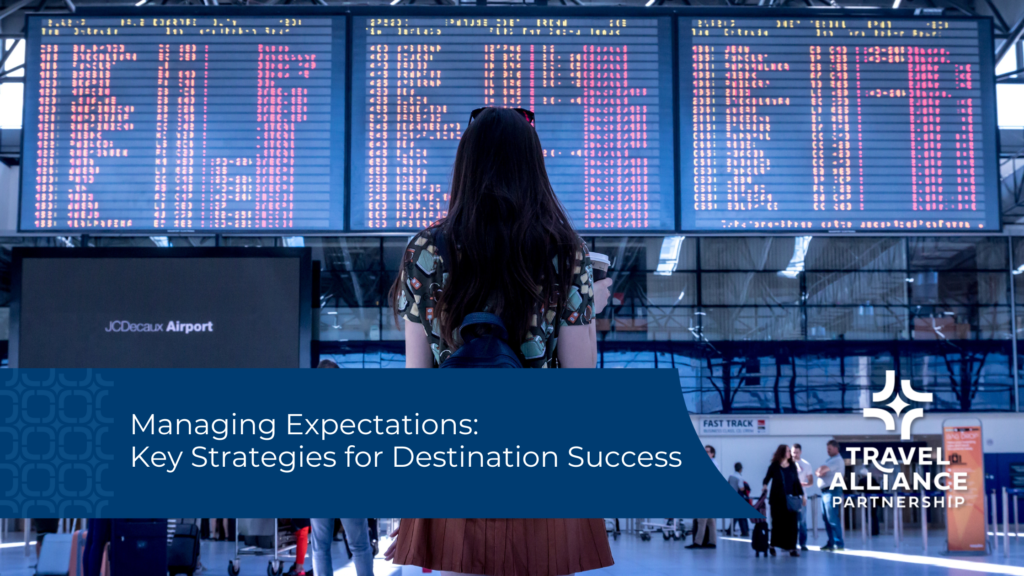Managing Expectations: Key Strategies for Destination Success
Managing expectations is not just a task – it’s an integral part of how destinations position themselves with travelers, partners and stakeholders. All relationships work in service to the traveler, and they are more informed and discerning than ever before. In fact, according to TravelAdvisor, 72% of travelers frequently read reviews before making a decision on places to stay and eat, or things to do. Because of this, the ability to set clear expectations (or to exceed them) can set a destination apart from their competitors. This involves a deep understanding of the industry, innovative thinking, and a commitment to visitor satisfaction.

We asked some of our TAP Guild Members how they manage expectations with tour operators, partners, and stakeholders to create the best visitor experience and here’s what they had to say:
Set Realistic Expectations:
Communication
I establish straightforward and consistent communication channels and make sure clients understand the scope, timelines, what to expect. But most importantly, I listen.
Shawna Faniel, Alabama Tourism
Travelers want to be prepared for anything. In your marketing and outreach, be sure to provide detailed information about what is included in packages, any additional costs, and what travelers need to keep in mind. This can include everything from weather conditions to local customs and potential challenges, depending on your destination and offerings.
Transparency
Full transparency is key to trust. I am completely candid with clients. If I don’t think an attraction, hotel, dining experience or destination is going to be a good fit for them, I would rather be up front than get the sale. Of course, I always offer a better option when possible!
Marlene Smith, Traverse City Tourism
Underpromise and overdeliver. While destinations obviously want to ensure their marketing materials positively depict the experience, full transparency leads to trust between destinations and their visitors. In an article from Business.com, millennial and Gen Z consumers, with 79 percent and 74 percent respectively, say that transparency is important to them in marketing and communications. By setting realistic expectations and then exceeding them, destinations can create memorable experiences that leave guests pleasantly surprised. This strategy not only enhances satisfaction but also encourages repeat visits and long-term loyalty.
Enhance The Experience:
Personalization
Listen, Listen, Listen. Know your clients’ market, whether senior adult market, student market, church group, etc. Give the clients assistance in knowing your product, if they have never visited your destination or venue before; invite them for a FAM.
Sandy Haines, Visit Myrtle Beach
Personalized recommendations and services can turn a good trip into a great one. The travel and tourism industry is seeing increased interest across the board in hyper-personalized experiences using previous booking data. Use this information to your advantage.
Creativity
Share positivity always, don’t get discouraged easily, find plan B,C or Z! Be creative and think “out of the box”. Your creativity shows them you are really trying to provide their best experience!
Jill Shorkey, Go Great Lakes Bay Regional CVB
Think outside the box! Creativity shows that you’re trying to provide the best experience. Plus, innovative ways of thinking could provide new opportunities for your destination to venture into.
Engagement
Be grateful. Thank them for choosing you, your venue, region etc. Thanking them for their business never gets old!
Jill Shorkey, Go Great Lakes Bay Regional CVB
Engage with visitors and partners before, during, and after their trip. Pre-arrival emails with tips and suggestions, real-time support through apps or chat services during their stay, and follow-up surveys or thank-you notes post-visit can enhance the overall experience. Managing expectations is an ongoing process, so don’t be afraid to ask for feedback to make the process smoother.
When I get an inquiry from an operator who needs help tweaking an itinerary, or a VTN member with a question, I work hard at replying by the end of the day or the next day at the latest. The reply may not include a solution but may simply be a message that I acknowledge their inquiry and will get back to them soon.
Marc Plouffe, Vermont Tourism Network
Effectively managing expectations is more than just a marketing strategy—it’s the key to creating exceptional travel experiences. By embracing creativity and maintaining engagement throughout the visitor journey, you can not only meet but surpass expectations, fostering memorable experiences and long-term loyalty. As the travel landscape continues to evolve, staying ahead by exceeding expectations will set your destination apart, ensuring visitors and partners return and recommend you to others.
Author
Related Posts
10 Must-Listen Podcasts for Travel, Tourism & Hospitality Professionals
I’ve had the joy of hosting Destination on the Left—an award-winning podcast spotlighting the travel, tourism, and hospitality industry—since 2016. My team and I believe…
How Tourism Brand Ambassadors Elevate Your Destination Story
In today’s world, it can seem like everything in marketing and sales has changed. But the one thing that hasn’t changed is the value of...
